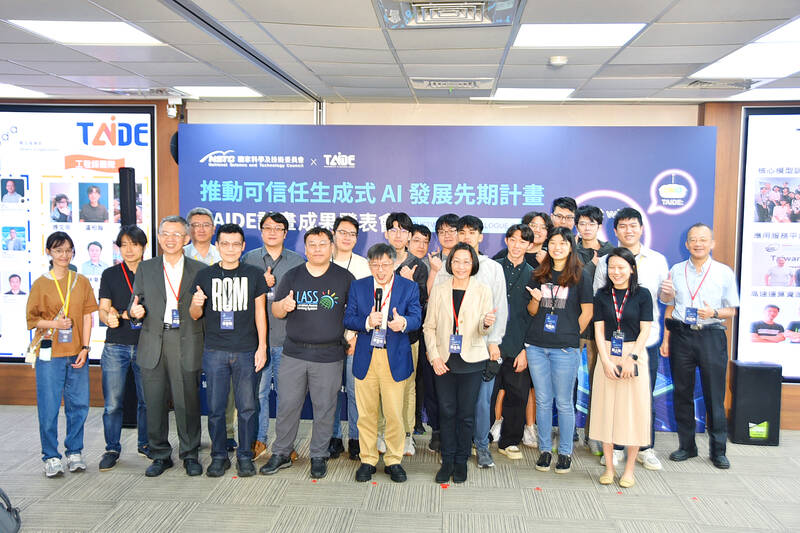A presentation yesterday on Taiwan’s self-built language model TAIDE, released commercially on April 15, showed the many fields it can be applied to, from language learning and agricultural knowledge searches to banking customer service.
The project to develop TAIDE, which stands for Trustworthy AI Dialogue Engine, was initiated by the National Science and Technology Council (NSTC) in April last year to create a foundational model for a traditional Chinese generative AI dialogue engine specifically for Taiwan.
The NSTC has collaborated with several institutions on the project over the past year, and a number of them appeared at yesterday’s presentation in Taipei to promote the system and demonstrate some of its applications.

Photo: Wu Po-hsuan, Taipei Times
For example, a team from the University of Tainan, led by computer science and information engineering professor Lee Chang-shing (李建興), developed a Taiwanese Hokkien-English AI chatbot for elementary and junior-high students based on TAIDE to learn the languages.
National Chung Hsing University has created an agricultural knowledge search engine called “Divine Farmer TAIDE” that can answer professional agricultural questions with citations, said Fan Yao-chung (范耀中), an associate professor of computer science and engineering at the university.
He said the answers generated through “Divine Farmer TAIDE” are more “context-based and detailed” than an engine the team previously developed based on ChatGPT because the new model includes reports from the Ministry of Agriculture in its database.
Taiwan Business Bank, in collaboration with an AI company, has applied TAIDE to help the bank’s employees access internal financial product information — which can be complicated and is continuously being updated — to help them provide better customer service.
The TAIDE model is “grounded in Taiwanese culture, incorporating unique elements such as Taiwanese language, values, and customs, enabling generative AI to understand and respond to the needs of local users,” the council said.
A TAIDE model based on Meta’s Llama 2 (Large Language Model Meta AI) model (TAIDE-LX-7B) was released for commercial use on April 15, and another version for research only (TAIDE-LX-13B) has also been released.
NSTC minister Wu Tsung-tsong (吳政忠) said the TAIDE LX-7B has been downloaded more than 6,000 times in the half month since it was released, showing that there is demand for a traditional Chinese-based foundational model with a contextual understanding of Taiwan.
Announcing that the project would be extended for another year, Wu compared TAIDE to a car engine, adding that it would be up to different fields to use the model to “make their own cars.”
However, Lee Yuh-jye (李育杰), a research fellow at the Research Center for Information Technology Innovation and a TAIDE project convener, said that TAIDE is not aimed at competing with other major engines.
Llama 3 is trained by 24,000 Nvidia’s H100 GPU (graphics processing unit, which has become the backbone of artificial training training), while Mixtral, another large language model, has 1,500, and “we only have 72.”
“What we have to do is to play smart,” not big, Lee said.

Taiwan is to commence mass production of the Tien Kung (天弓, “Sky Bow”) III, IV and V missiles by the second quarter of this year if the legislature approves the government’s NT$1.25 trillion (US$39.78 billion) special defense budget, an official said yesterday. Commenting on condition of anonymity, a defense official with knowledge of the matter said that the advanced systems are expected to provide crucial capabilities against ballistic and cruise missiles for the proposed “T-Dome,” an advanced, multi-layered air defense network. The Tien Kung III is an air defense missile with a maximum interception altitude of 35km. The Tien Kung IV and V

The disruption of 941 flights in and out of Taiwan due to China’s large-scale military exercises was no accident, but rather the result of a “quasi-blockade” used to simulate creating the air and sea routes needed for an amphibious landing, a military expert said. The disruptions occurred on Tuesday and lasted about 10 hours as China conducted live-fire drills in the Taiwan Strait. The Civil Aviation Administration (CAA) said the exercises affected 857 international flights and 84 domestic flights, affecting more than 100,000 travelers. Su Tzu-yun (蘇紫雲), a research fellow at the government-sponsored Institute for National Defense and Security Research, said the air

A strong continental cold air mass is to bring pollutants to Taiwan from tomorrow, the Ministry of Environment said today, as it issued an “orange” air quality alert for most of the country. All of Taiwan except for Hualien and Taitung counties is to be under an “orange” air quality alert tomorrow, indicating air quality that is unhealthy for sensitive groups. In China, areas from Shandong to Shanghai have been enveloped in haze since Saturday, the ministry said in a news release. Yesterday, hourly concentrations of PM2.5 in these areas ranged from 65 to 160 micrograms per cubic meter (mg/m³), and pollutants were

Taiwan’s armed forces have established response protocols for a wide range of sudden contingencies, including the “Wan Chun Plan” to protect the head of state, the Ministry of Defense (MND) said today. After US President Donald Trump on Saturday launched a series of airstrikes in Venezuela and kidnapped Venezuelan President Nicolas Maduro, concerns have been raised as to whether China would launch a similar “decapitation strike” on Taiwan. The armed forces regularly coordinate with relevant agencies and practice drills to ensure preparedness for a wide range of scenarios, Vice Minister of National Defense Hsu Szu-chien (徐斯儉) told reporters before a